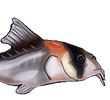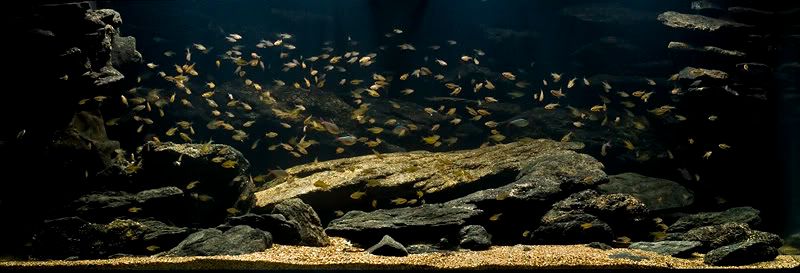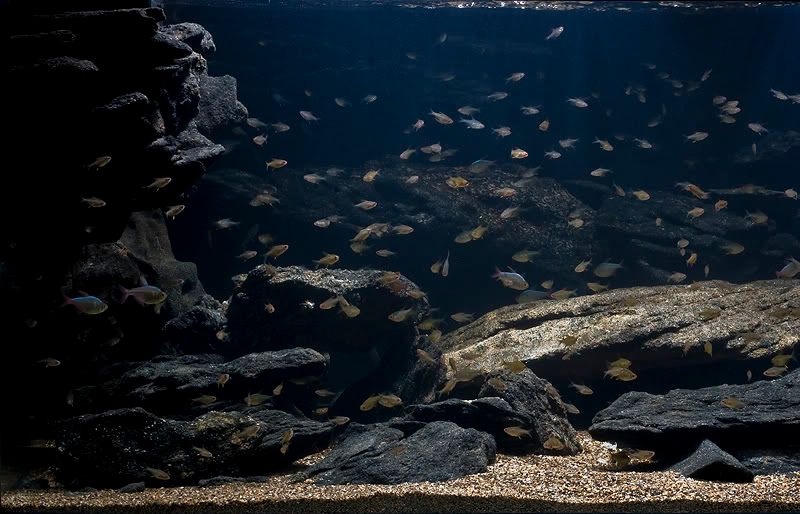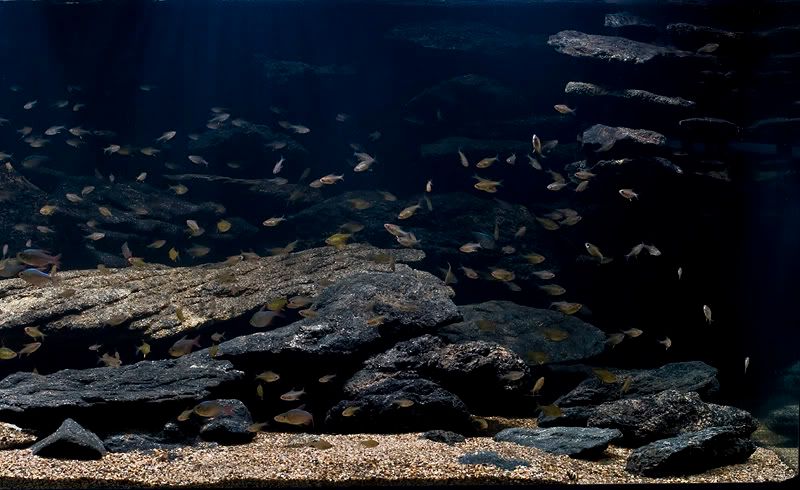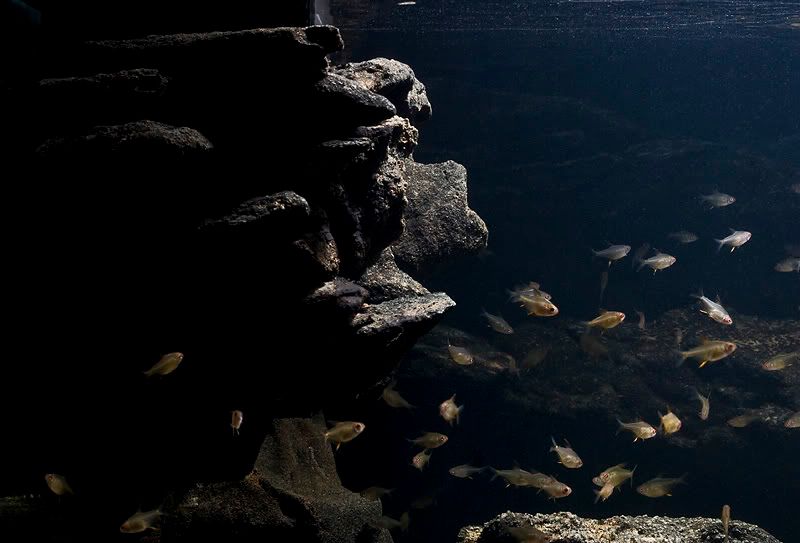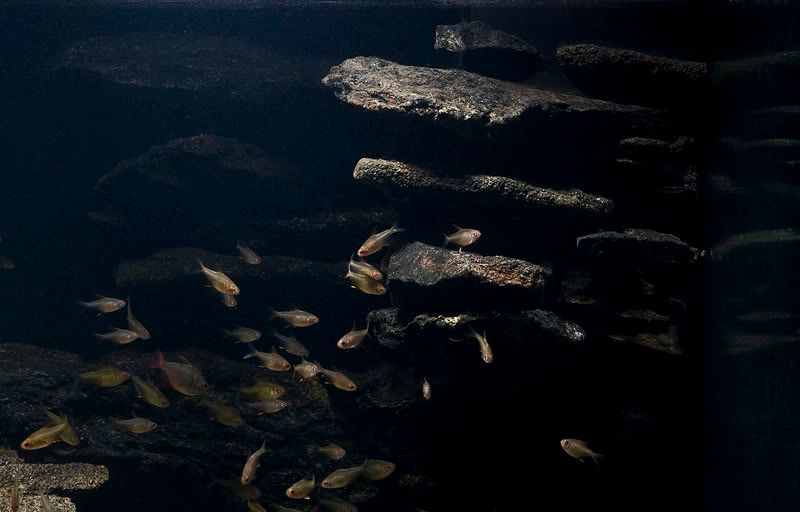what type of rock is that? ..............go easy on me im newHaavard Stoere wrote:All plans changed, and I build a rockscape instead for my second 720 liter tank.
It was built in much the same way as my Green phantom tank, but with darker rocks. At the moment I keep 7 Hemiancistrus sp. L-128 and 7 Baryancistrus dematoides L-200 "hi-fin". I removed most of the several hundred of lemon tetras tonight, so that I can photograph the catfish over the next few weeks. In the near future I only want a small school of Colombian tetras as company for myself and the catfish. Huge shoals of fish are nice, but it makes photograpy difficult. I will not keep discus in this tank as it is totally unsuitable.
This is the whole tank earlyer today:
Left side of the tank:
Right side of the tank:
Left side filtermodule containing 3000lph powerhead an the in/outlets of the Eheim 2080:
Right side filtermodule containing 3000lph powerhead:
720 liter pleco, discus and tetra tank
Re: 720 liter pl*co, discus and tetra tank
-
Haavard Stoere
- Posts: 1128
- Joined: 27 Jan 2005, 22:56
- My articles: 3
- My images: 62
- My cats species list: 22 (i:0, k:0)
- My aquaria list: 10 (i:9)
- Spotted: 16
- Location 1: Norway, Stavanger
Re: 720 liter pl*co, discus and tetra tank
The rocks are from the coastal area of Norway where I live. I don`t know the name of the rocks or if the rocks even have a name. I can at least say that they are not made from sediments.
- MatsP
- Posts: 21038
- Joined: 06 Oct 2004, 13:58
- My articles: 4
- My images: 28
- My cats species list: 117 (i:33, k:0)
- My aquaria list: 10 (i:8)
- My BLogs: 4 (i:0, p:164)
- Spotted: 187
- Location 1: North of Cambridge
- Location 2: England.
Re: 720 liter pl*co, discus and tetra tank
A large proportion of the rock of Norway is granite (same rock that makes up most of Sweden), but of course just because most of it is granite doesn't make these pieces parts of that.
--
Mats
--
Mats
Re: 720 liter pl*co, discus and tetra tank
what ever it is i want some that tank looks awsome 
-
Haavard Stoere
- Posts: 1128
- Joined: 27 Jan 2005, 22:56
- My articles: 3
- My images: 62
- My cats species list: 22 (i:0, k:0)
- My aquaria list: 10 (i:9)
- Spotted: 16
- Location 1: Norway, Stavanger
Re: 720 liter pl*co, discus and tetra tank
The most important thing is to observe how rocks behave in nature, and try to place the rocks in the same fashion as where they were collected. The rocks themselves don`t need to be spectacular. It is the relationship between the pieces that makes the landscape.
- MatsP
- Posts: 21038
- Joined: 06 Oct 2004, 13:58
- My articles: 4
- My images: 28
- My cats species list: 117 (i:33, k:0)
- My aquaria list: 10 (i:8)
- My BLogs: 4 (i:0, p:164)
- Spotted: 187
- Location 1: North of Cambridge
- Location 2: England.
Re: 720 liter pl*co, discus and tetra tank
That is a very good point.Haavard Stoere wrote:The most important thing is to observe how rocks behave in nature, and try to place the rocks in the same fashion as where they were collected. The rocks themselves don`t need to be spectacular. It is the relationship between the pieces that makes the landscape.
--
Mats
- Richard B
- Posts: 6952
- Joined: 11 Aug 2006, 13:19
- I've donated: $20.00!
- My articles: 9
- My images: 11
- My cats species list: 37 (i:0, k:0)
- My aquaria list: 4 (i:0)
- My BLogs: 2 (i:0, p:29)
- Spotted: 10
- Location 1: on the sofa, or maybe at work?
- Location 2: Warwickshire: UK
- Interests: Tanganyika Catfish, African catfish, Non-loricariid sucker-catfish.
Running, drinking, eating, sci-fi, stapelids
Re: 720 liter pl*co, discus and tetra tank
I'm generally not one to hold back on praise as it is often due, but personally after following most of Haavard's threads i would say the aquascapes are a work of pure genius! 
Lou: Every young man's fantasy is to have a three-way.
Jacob: Yeah not with another fu**!ng guy!
Lou: It's still a three-way!
Hot Tub Time Machine: 2010
Jacob: Yeah not with another fu**!ng guy!
Lou: It's still a three-way!
Hot Tub Time Machine: 2010
- Martin S
- Posts: 2100
- Joined: 26 Mar 2003, 11:14
- I've donated: $20.00!
- My images: 9
- My cats species list: 90 (i:19, k:0)
- Spotted: 17
- Location 1: Guildford, Surrey
- Location 2: UK
- Interests: Aquatics
Re: 720 liter pl*co, discus and tetra tank
I have to agree with you Richard. One of the other things that really comes through from reading Haavard's threads is his passion for all apsects of fishkeeping.Richard B wrote:I'm generally not one to hold back on praise as it is often due, but personally after following most of Haavard's threads i would say the aquascapes are a work of pure genius!
Martin
Re: 720 liter pl*co, discus and tetra tank
thanks mate that makes alot of scenseHaavard Stoere wrote:The most important thing is to observe how rocks behave in nature, and try to place the rocks in the same fashion as where they were collected. The rocks themselves don`t need to be spectacular. It is the relationship between the pieces that makes the landscape.
- MatsP
- Posts: 21038
- Joined: 06 Oct 2004, 13:58
- My articles: 4
- My images: 28
- My cats species list: 117 (i:33, k:0)
- My aquaria list: 10 (i:8)
- My BLogs: 4 (i:0, p:164)
- Spotted: 187
- Location 1: North of Cambridge
- Location 2: England.
Re: 720 liter pl*co, discus and tetra tank
Just beware that A LOT of local rock is calciferous in England. If you live up-north, you may be OK (Lake District or more north), or if you live in Cornwall. But if you are anywhere within 100 miles of London, then I'd say you probably are better off going for some other source than "nature".russ1979 wrote:thanks mate that makes alot of scense. im just looking to get some rocks in the wild i haven't got a clue which is good or bad and i haven't got the money to pay the LFS prices
You can get good stone from garden centres. Slate is OK for use in fish-tanks, as is quartz, granite and basalt. Marble, dolomite is not.
--
Mats
Re: 720 liter pl*co, discus and tetra tank
im from the isle of wight mate don't think iv'e much chance thenMatsP wrote:Just beware that A LOT of local rock is calciferous in England. If you live up-north, you may be OK (Lake District or more north), or if you live in Cornwall. But if you are anywhere within 100 miles of London, then I'd say you probably are better off going for some other source than "nature".russ1979 wrote:thanks mate that makes alot of scense. im just looking to get some rocks in the wild i haven't got a clue which is good or bad and i haven't got the money to pay the LFS prices
You can get good stone from garden centres. Slate is OK for use in fish-tanks, as is quartz, granite and basalt. Marble, dolomite is not.
--
Mats
- MatsP
- Posts: 21038
- Joined: 06 Oct 2004, 13:58
- My articles: 4
- My images: 28
- My cats species list: 117 (i:33, k:0)
- My aquaria list: 10 (i:8)
- My BLogs: 4 (i:0, p:164)
- Spotted: 187
- Location 1: North of Cambridge
- Location 2: England.
Re: 720 liter pl*co, discus and tetra tank
Nice coloured sand, but not a good place for finding good rocks for your tank, unfortuantely.
Garden centres, however, often sell larger lumps of stone per kilo, and whilst it's not "free" it's often better than the fish shop - and the stones in the fish shop probably comes from exactly the same gravel pit or quarry.
--
Mats
Garden centres, however, often sell larger lumps of stone per kilo, and whilst it's not "free" it's often better than the fish shop - and the stones in the fish shop probably comes from exactly the same gravel pit or quarry.
--
Mats
Re: 720 liter pl*co, discus and tetra tank
r mostly all types of metophoric rocks okMatsP wrote:Nice coloured sand, but not a good place for finding good rocks for your tank, unfortuantely.
Garden centres, however, often sell larger lumps of stone per kilo, and whilst it's not "free" it's often better than the fish shop - and the stones in the fish shop probably comes from exactly the same gravel pit or quarry.
--
Mats
- MatsP
- Posts: 21038
- Joined: 06 Oct 2004, 13:58
- My articles: 4
- My images: 28
- My cats species list: 117 (i:33, k:0)
- My aquaria list: 10 (i:8)
- My BLogs: 4 (i:0, p:164)
- Spotted: 187
- Location 1: North of Cambridge
- Location 2: England.
Re: 720 liter pl*co, discus and tetra tank
Do you mean "metamorphic"? I don't know for sure. Basically, we want chemically inert stone - stone that don't change the water conditions.
--
Mats
--
Mats
-
Haavard Stoere
- Posts: 1128
- Joined: 27 Jan 2005, 22:56
- My articles: 3
- My images: 62
- My cats species list: 22 (i:0, k:0)
- My aquaria list: 10 (i:9)
- Spotted: 16
- Location 1: Norway, Stavanger
Re: 720 liter pl*co, discus and tetra tank
One always tends to find rocks and landscapes that are exotic to us more attractive than our own local stuff.
My favourite rock collecting trips were in the south of england a couple of years ago. My younger brother, my father and me collected rocks and fossils at Lyme Regis and Charmouth beach. The rocks there are rather porous, and makes the aquarium water alcaline and hard. Not at all suitable for use in pleco tanks.
My brother and me at Lyme Regis
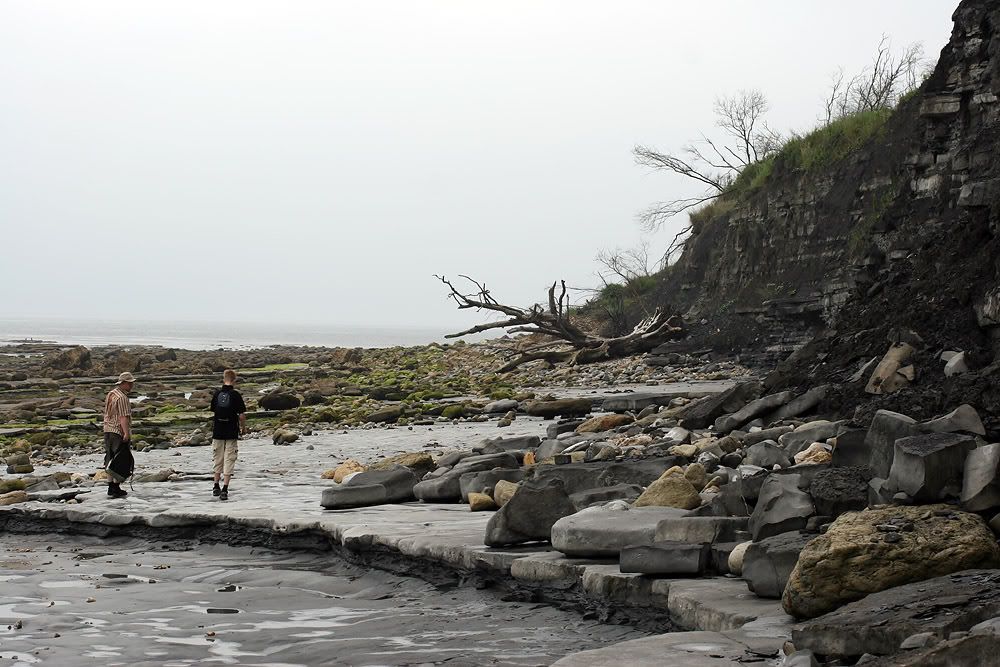
Charmouth Beach... The idiot risking his life under the cliffs is me. It is incredibly exiting to be the first to scavange through new landslides. The stuff there haven`t seen daylight in 160 million years. We don`t have these fossil meckas in Norway.
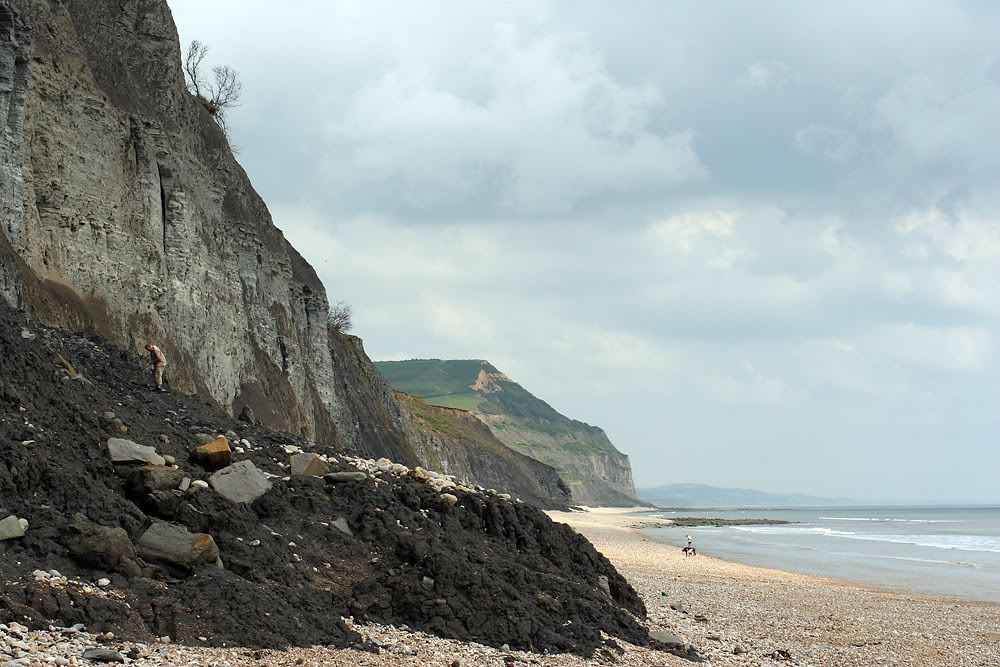
I used some of the rocks and fossils in this 200liter setup for green shrimps (Caridina babaulti). The fog is from gibsen added to make the water even harder. The substrate is made from pieces of ammonites and belemnites.
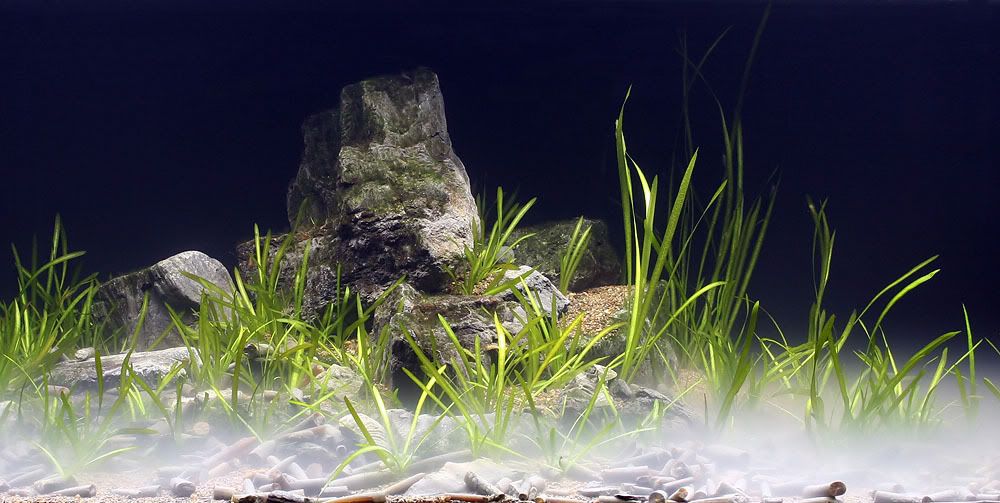
My favourite rock collecting trips were in the south of england a couple of years ago. My younger brother, my father and me collected rocks and fossils at Lyme Regis and Charmouth beach. The rocks there are rather porous, and makes the aquarium water alcaline and hard. Not at all suitable for use in pleco tanks.
My brother and me at Lyme Regis

Charmouth Beach... The idiot risking his life under the cliffs is me. It is incredibly exiting to be the first to scavange through new landslides. The stuff there haven`t seen daylight in 160 million years. We don`t have these fossil meckas in Norway.

I used some of the rocks and fossils in this 200liter setup for green shrimps (Caridina babaulti). The fog is from gibsen added to make the water even harder. The substrate is made from pieces of ammonites and belemnites.

- MatsP
- Posts: 21038
- Joined: 06 Oct 2004, 13:58
- My articles: 4
- My images: 28
- My cats species list: 117 (i:33, k:0)
- My aquaria list: 10 (i:8)
- My BLogs: 4 (i:0, p:164)
- Spotted: 187
- Location 1: North of Cambridge
- Location 2: England.
Re: 720 liter pl*co, discus and tetra tank
Yes, my point exactly about southern englands rocks: They make the water hard. And as opposed to most of Norway, southern England water is already quite hard, so no need to add gypsum [Gibsen is perhaps the Norwegian for Gypsum].
--
Mats
--
Mats
- racoll
- Posts: 5258
- Joined: 26 Jan 2004, 12:18
- My articles: 6
- My images: 182
- My catfish: 2
- My cats species list: 2 (i:2, k:0)
- My aquaria list: 1 (i:0)
- Spotted: 238
- Location 1: London
- Location 2: UK
Re: 720 liter pl*co, discus and tetra tank
The trick to getting these stunning aquascapes is patience, patience, patience, and an eye for the aesthetic.
Sadly I lack both of these qualities, but I do own a copy of Takashi Amano's Nature Aquarium World, which beautifully explains the principles involved, such as the "golden ratio".
Attention to detail is another critical factor - for example having a substrate of the same colour as the rocks will make a huge difference in tricking the eye to "believe" in the aquascape.
Also, you must never compromise or cut corners, or you will end up with sub-standard results!
As for the rocks, my LFS sells rocks in the shop at £2/kg, but outside in the garden/pond area sells the same rocks for £2 each regardless of size!
Haarvard, what lighting are you using on the plec tank?
Sadly I lack both of these qualities, but I do own a copy of Takashi Amano's Nature Aquarium World, which beautifully explains the principles involved, such as the "golden ratio".
Attention to detail is another critical factor - for example having a substrate of the same colour as the rocks will make a huge difference in tricking the eye to "believe" in the aquascape.
Also, you must never compromise or cut corners, or you will end up with sub-standard results!
As for the rocks, my LFS sells rocks in the shop at £2/kg, but outside in the garden/pond area sells the same rocks for £2 each regardless of size!
Haarvard, what lighting are you using on the plec tank?
-
Haavard Stoere
- Posts: 1128
- Joined: 27 Jan 2005, 22:56
- My articles: 3
- My images: 62
- My cats species list: 22 (i:0, k:0)
- My aquaria list: 10 (i:9)
- Spotted: 16
- Location 1: Norway, Stavanger
Re: 720 liter pl*co, discus and tetra tank
Everyday lighting is from a hanging lamp containing 2x36 watt t8 with cheap Biltema daylight tubes.
When photographing fish I use external flashlamps tied to the hanging lamp directing the light vertically upon the tank.
This picture shows the 4 portaflash lamps that are connected to the camera via cabel.
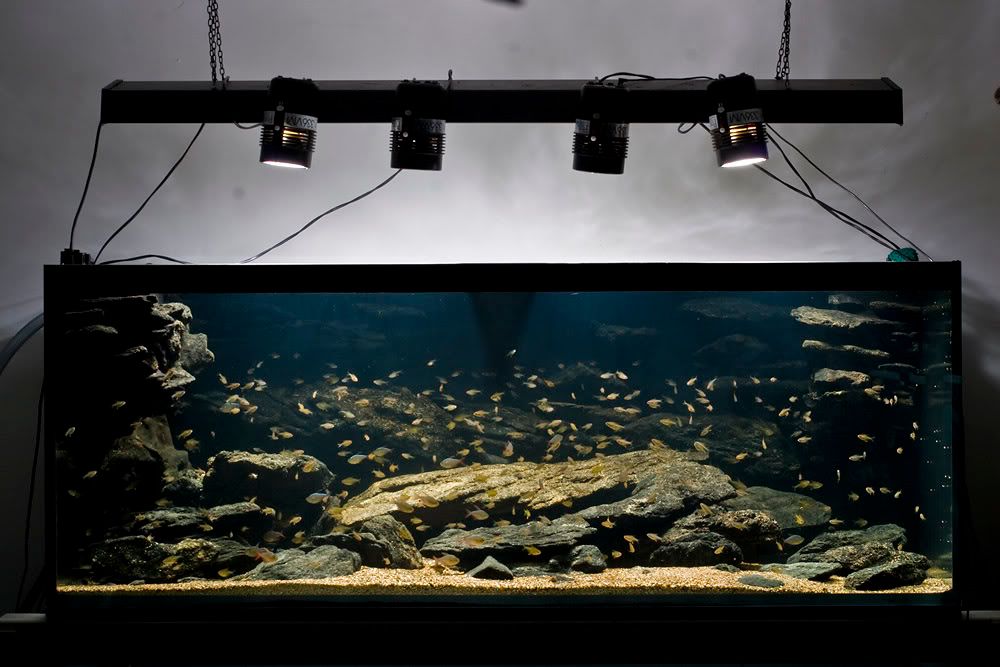
When photographing fish I use external flashlamps tied to the hanging lamp directing the light vertically upon the tank.
This picture shows the 4 portaflash lamps that are connected to the camera via cabel.

-
Haavard Stoere
- Posts: 1128
- Joined: 27 Jan 2005, 22:56
- My articles: 3
- My images: 62
- My cats species list: 22 (i:0, k:0)
- My aquaria list: 10 (i:9)
- Spotted: 16
- Location 1: Norway, Stavanger
Re: 720 liter pl*co, discus and tetra tank
Yeah! Gypsum is the correct word. Had to look in WikipediaMatsP wrote:Yes, my point exactly about southern englands rocks: They make the water hard. And as opposed to most of Norway, southern England water is already quite hard, so no need to add gypsum [Gibsen is perhaps the Norwegian for Gypsum].
--
Mats
- Carp37
- Posts: 596
- Joined: 21 Sep 2007, 13:08
- My cats species list: 16 (i:7, k:0)
- My aquaria list: 7 (i:6)
- My BLogs: 2 (i:0, p:51)
- Location 2: Aughton UK
- Interests: fish, fishing, fossils, evolution/taxonomy, films
Re: 720 liter pl*co, discus and tetra tank
Whilst I agree with Rupert about lacking these quantities (me, not Rupert) I also think a degree of technical competence/aptitude is required. Judging by other comments on Harvaard's threads I'm not alone in thinking that Harvaard's tanks are the most aesthetically pleasing I've seen, but even with the same materials (and a good eye) I wouldn't be able to assemble the aquascape effectively.racoll wrote:The trick to getting these stunning aquascapes is patience, patience, patience, and an eye for the aesthetic.
My own tanks are more a case of find what slate I've got left in my dad's loft, from my tanks 17 years ago, buy new gravel, buy wood, shove them in the tank, then have to buy pretty hideous plastic plants to give some vertical element to the tank and to make the cichlids dodge round them rather than charge each other across the length of the tank, or where cichlids are absent to give some cover for grumpy cats.
Megalechis thoracata, Callichthys callichthys, Brochis splendens (and progeny), Corydoras sterbai, C. weitzmani, CW044 cf. pestai, CW021 cf. axelrodi, Pterygoplichthys gibbiceps, Ancistrus cf. cirrhosus (and progeny), Panaque maccus, Panaque nigrolineatus, Synodontis eupterus
Re: 720 liter pl*co, discus and tetra tank
Thanks for the advice its really got me thinking about my tank. I have been fishkeeping for just under 2 years and my tank looks like your average fishkeepers tank with not much of it being in tune with nature in the way it has been set up. so thanks for your ideas keep them coming, can anyone recommend any other books??
Re: 720 liter pl*co, discus and tetra tank
note the background has been changed to black
- Birger
- Expert
- Posts: 3870
- Joined: 01 Dec 2003, 05:04
- My articles: 10
- My images: 112
- My cats species list: 49 (i:43, k:0)
- Spotted: 35
- Location 1: Edmonton,Alberta
- Location 2: Canada
Re: 720 liter pl*co, discus and tetra tank
Not that it was bad to post here but why don't you start a thread specifically about your tank and then everyone can see the difference the extra time and effort makes as your tank develops into what you wish it to be.Thanks for the advice its really got me thinking about my tank. I have been fishkeeping for just under 2 years and my tank looks like your average fishkeepers tank with not much of it being in tune with nature in the way it has been set up. so thanks for your ideas keep them coming, can anyone recommend any other books??
Birger
Birger
- Lihn
- Posts: 124
- Joined: 18 Jan 2008, 23:02
- My images: 10
- My cats species list: 6 (i:0, k:0)
- Spotted: 3
- Location 1: Denmark
- Location 2: Denmark
- Interests: South American catfishes, Loricariidae
- Contact:
Re: 720 liter pl*co, discus and tetra tank
Very beautifull tank(s) Haavard. You are really good to make exciting aquariums, I am impressed!
Regards
Jacob
Now I breed the following species: 12 Peckoltia compta - L134 and 10 Ancistrus L107/L184
I have earlier bred these plecos: L010a, Ancistrus sp., L183, L260, Hypancistrus contradens
Jacob
Now I breed the following species: 12 Peckoltia compta - L134 and 10 Ancistrus L107/L184
I have earlier bred these plecos: L010a, Ancistrus sp., L183, L260, Hypancistrus contradens
-
Haavard Stoere
- Posts: 1128
- Joined: 27 Jan 2005, 22:56
- My articles: 3
- My images: 62
- My cats species list: 22 (i:0, k:0)
- My aquaria list: 10 (i:9)
- Spotted: 16
- Location 1: Norway, Stavanger
Re: 720 liter pl*co, discus and tetra tank
An update of the tank.
The tank houses 7 Hemiancistrus sp. L128, 7 Baryancistrus demantoides and 19 columbian tetras.
Yesterday evening/night I got some inspiration with a little aid from a bottle of red wine. I pulled out the largest rock, and redesigned the lower part of the tank to make more space in the middle. Under each pile of rocks there are large slate caves for the plecos to hide in. In this picture you can see both of the large male Hemiancistrus sp. L128.
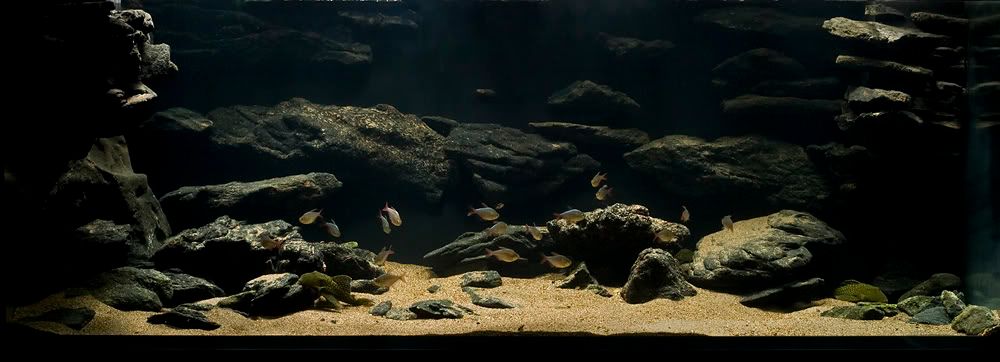
My two biggest Hemiancistrus sp. L128 are definite males. They occupy one half of the tank each. There are some quarrels, but I haven`t seen any sign of a real fight yet. They have become very hairy and beautiful.
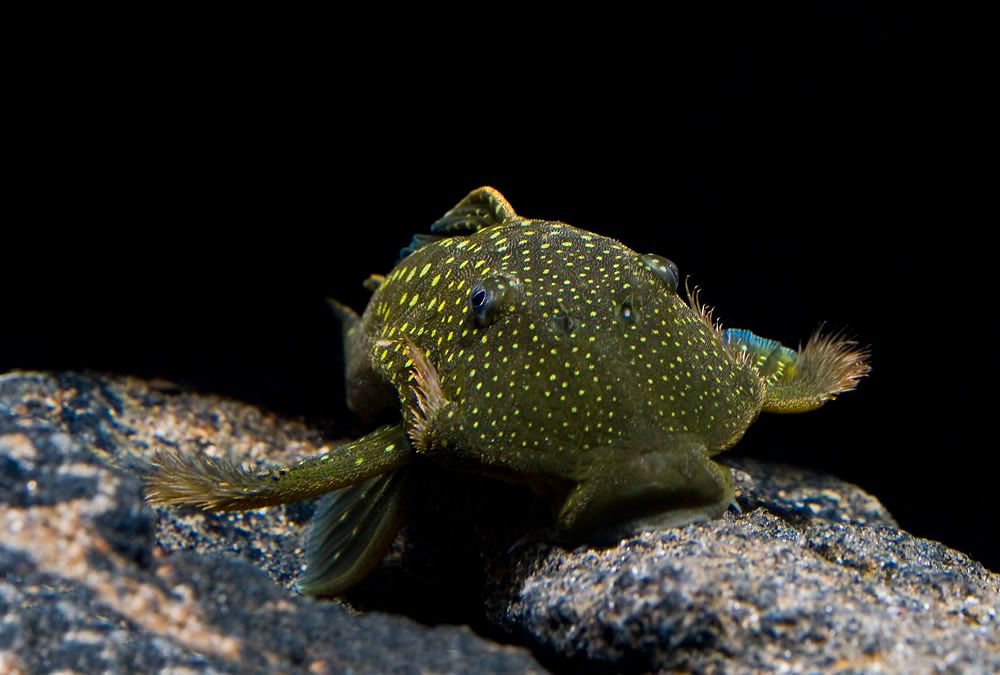
Every morning when I turn the lights on the 19 colombian tetras starts patrolling in tight formation around the tank. During the day they are scattered more around the tank. I really like the size of these fish. Perfect for a large tank. The fast currents are not a problem.
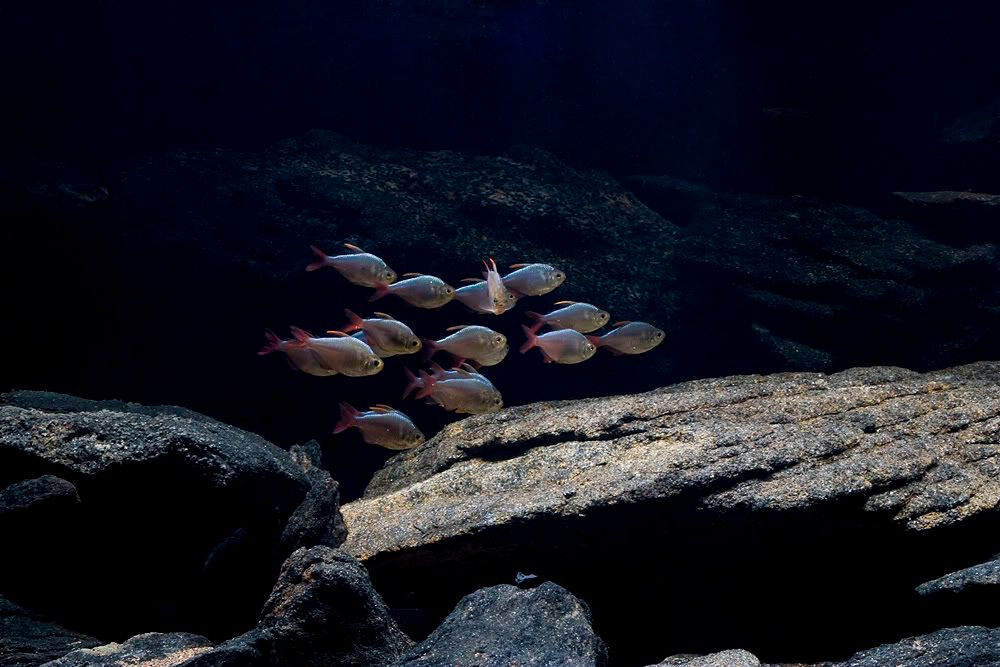
The tank houses 7 Hemiancistrus sp. L128, 7 Baryancistrus demantoides and 19 columbian tetras.
Yesterday evening/night I got some inspiration with a little aid from a bottle of red wine. I pulled out the largest rock, and redesigned the lower part of the tank to make more space in the middle. Under each pile of rocks there are large slate caves for the plecos to hide in. In this picture you can see both of the large male Hemiancistrus sp. L128.

My two biggest Hemiancistrus sp. L128 are definite males. They occupy one half of the tank each. There are some quarrels, but I haven`t seen any sign of a real fight yet. They have become very hairy and beautiful.

Every morning when I turn the lights on the 19 colombian tetras starts patrolling in tight formation around the tank. During the day they are scattered more around the tank. I really like the size of these fish. Perfect for a large tank. The fast currents are not a problem.

- Richard B
- Posts: 6952
- Joined: 11 Aug 2006, 13:19
- I've donated: $20.00!
- My articles: 9
- My images: 11
- My cats species list: 37 (i:0, k:0)
- My aquaria list: 4 (i:0)
- My BLogs: 2 (i:0, p:29)
- Spotted: 10
- Location 1: on the sofa, or maybe at work?
- Location 2: Warwickshire: UK
- Interests: Tanganyika Catfish, African catfish, Non-loricariid sucker-catfish.
Running, drinking, eating, sci-fi, stapelids
Re: 720 liter pl*co, discus and tetra tank
Great photo of the Male 128 - very hairy indeed!!!
Nice looking tetras too.
Nice looking tetras too.
Lou: Every young man's fantasy is to have a three-way.
Jacob: Yeah not with another fu**!ng guy!
Lou: It's still a three-way!
Hot Tub Time Machine: 2010
Jacob: Yeah not with another fu**!ng guy!
Lou: It's still a three-way!
Hot Tub Time Machine: 2010
-
HeadHunter
- Posts: 13
- Joined: 01 Sep 2008, 18:24
- My cats species list: 6 (i:0, k:0)
- My aquaria list: 1 (i:0)
- Location 1: Eindhoven, The Netherlands
- Location 2: Netherlands
- Interests: aquarium, catfish, martial arts, girls :P
- Contact:
Re: 720 liter pl*co, discus and tetra tank
niceeeee 
i rlly love to see pics of the L128
they r BEAUTIFULL!!!
greeetz HeadHunter
i rlly love to see pics of the L128
they r BEAUTIFULL!!!
greeetz HeadHunter
Rio 400
hardcore is a feeling thats inside of us, it will never die!
hardcore is a feeling thats inside of us, it will never die!
- I_Xeno
- Posts: 101
- Joined: 23 Jul 2006, 22:27
- I've donated: $5.00!
- My images: 7
- My cats species list: 15 (i:0, k:0)
- Spotted: 3
- Location 2: Europe
Re: 720 liter pl*co, discus and tetra tank
Very nice tank 
- pramirez
- Posts: 16
- Joined: 19 Jul 2007, 15:40
- My cats species list: 3 (i:0, k:0)
- My aquaria list: 4 (i:0)
- Location 1: Spain
- Location 2: Spain
Re: 720 liter pl*co, discus and tetra tank
Hi Haavard.
You can get inspiration on the red vine whenever you want. Your L200-L128's tank looked incredible for me, now better. I think you'll never stop getting ready your set up. This is your destiny....and many times the vine or so can be a very good help.
By other hand, had you try whit any bogwoog with them? They really like to gnaw on it.
Regards.
You can get inspiration on the red vine whenever you want. Your L200-L128's tank looked incredible for me, now better. I think you'll never stop getting ready your set up. This is your destiny....and many times the vine or so can be a very good help.
By other hand, had you try whit any bogwoog with them? They really like to gnaw on it.
Regards.

